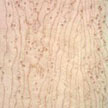 |
Birdseye Maple (Acer saccharum):
Birdseye is a type of figure found in hard maple. It shows best in flat sawn wood. There is a wide variety of sizes and shapes in the "eyes". Under a gloss finish, the Birdseye takes on a 3D look for a beautiful visual appeal. AAA grade means the wood will be a bit more figured than our standard AA.
Tone-O-Meter™
 |
|
YES |
NO |
|
| Used for neck backs |
X |
|
|
| Used for finger boards |
X |
|
|
| Finish required |
X |
|
|
| Used for bodies |
|
X |
Occasionally laminate tops |
|
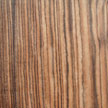 |
Bocote (Cordia elaeagnoiders):
Often referred to as Mexican Rosewood, striking grain patterns are the trademark of this dense, smooth wood. The grain is very tight so the feel is extremely fast and luxurious. Because of Bocote’s dense nature, you can expect great sustain and nice attack. Along with the usually wild figure of light and dark brown stripes, light yellow and light green hues are not uncommon and add to the uniqueness of this fine exotic. Limited availability.
Tone-O-Meter™
 |
|
YES |
NO |
|
| Used for neck backs |
X |
|
|
| Used for finger boards |
|
X |
|
| Finish required |
|
X |
|
| Used for bodies |
|
X |
|
|
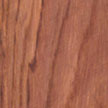 |
Brazilian Rosewood (Dalbergia nigra):
Long the premier Rosewood for fingerboards, this wood has become quite rare and expensive. It tends to be harder and sonically more vibrant than other rosewoods and it has a satiny feel to the fingers. Brazilian Rosewood color variations are extensive running from predominately light brown to very dark and even orange colors.
Tone-O-Meter™
 |
|
YES |
NO |
|
| Used for neck backs |
|
X |
|
| Used for finger boards |
X |
|
|
| Finish required |
|
X |
|
| Used for bodies |
|
X |
|
|
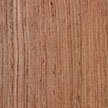 |
Bubinga (Guibourtia demeusei):
Fine grained and super smooth, Bubinga has long been a favorite of the discriminating ears of the famous. Used by companies such as Rickenbacker for fretboards and Warwick for bodies. As a bass neck, it brings bright midrange and a thick well defined bottom. Bubinga is also a very stiff wood adding strength and stability to its list of assets. This is one formidable tonewood!
Tone-O-Meter™
 |
|
YES |
NO |
|
| Used for neck backs |
X |
|
|
| Used for finger boards |
X |
|
|
| Finish required |
|
X |
|
| Used for bodies |
X |
|
And laminate tops too |
|
 |
Ebony (Dispyrus melanoxylon):
Very hard, smooth and fast feeling, it has a bright, long sustaining tone. Chocolate brown or dark gray streaks are not uncommon. Ebony has a long history of a preferred fingerboard choice of high end electric guitar builders. An excellent choice for fretless necks. Available primarily as fingerboards and occasionally for full neck construction.
Tone-O-Meter™
 |
|
YES |
NO |
|
| Used for neck backs |
X |
|
|
| Used for finger boards |
X |
|
|
| Finish required |
|
X |
|
| Used for bodies |
|
X |
|
|
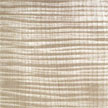 |
Flame Maple (Acer saccharum):
While there are several maple species that show the flame figure, the only one hard enough for making necks is Acer saccharum. Identical to plain Hard maple, except for the highly prized flame figuring. For even more flame figure, AAA grade can be requested. A different species of Flame Maple is used for body laminate tops.
Tone-O-Meter™
 |
|
YES |
NO |
|
| Used for neck backs |
X |
|
|
| Used for finger boards |
X |
|
|
| Finish required |
X |
|
|
| Used for bodies |
|
X |
|
|
 |
Hard Maple (Acer saccharum):
This is the most traditional Fender neck wood. Dense, hard and strong, offering great sustain and stability. The tone is bright. Maple must be finished to protect from warping. The figure varies greatly and does at times contain some Birdseye.
Tone-O-Meter™
 |
|
YES |
NO |
|
| Used for neck backs |
X |
|
|
| Used for finger boards |
X |
|
|
| Finish required |
X |
|
|
| Used for bodies |
|
X |
|
|
 |
Indian Rosewood (Dalbergia latifolia):
Here we have the most popular fingerboard wood! Indian Rosewood has the warm "rock-n-roll" tonality you’ve heard on many of the most famous rock albums in history. The warm tone is also a favorite amongst blues players. Rosewood contains natural oils so a finish is not required. The feel is also smooth and fast. Colors range from brown to dark purple to lighter purple with yellows and sometimes hues of orange and green.
Tone-O-Meter™
 |
|
YES |
NO |
|
| Used for neck backs |
X |
|
|
| Used for finger boards |
X |
|
|
| Finish required |
|
X |
|
| Used for bodies |
X |
|
|
|
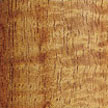 |
Koa (Acacia koa):
Koa comes from the Hawaiian Islands. Koa is similar to Mahogany in density and strength though it can look remarkable! Stripes of tans and brown can create interesting figure. Sometimes even flame figuring is available that really comes alive under a clear gloss. Koa sounds especially good when combined with a Pau Ferro or ebony fingerboard. Koa is highly prized in the wood market because of its limited availability so it is expensive. Koa must be hard finished.
Tone-O-Meter™
 |
|
YES |
NO |
|
| Used for neck backs |
X |
|
|
| Used for finger boards |
|
X |
|
| Finish required |
X |
|
|
| Used for body |
X |
|
|
|
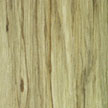 |
Korina/Limba (Terminalia superba):
Though Limba is its true name, Korina is the name most guitarists recognize for this wood. Its light yellow-green color is unique and looks aged even though new. In both tone and texture Korina is very similar to mahogany with just a touch more highs. Korina is only suitable for neck stock, not fretboards. Availability is limited or sporadic.
Tone-O-Meter™
 |
|
YES |
NO |
|
| Used for neck backs |
X |
|
|
| Used for finger boards |
|
X |
|
| Finish required |
X |
|
|
| Used for bodies |
X |
|
|
|
|
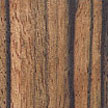 |
Macassar Ebony (Dispyrus macassar):
The distinctive chocolate brown stripes of Macassar Ebony are hard to miss. A beautiful wood for those wanting the feel and tone of ebony but a more exciting look! Lots of sustain, attack and stability from this dense wood and the feel is very smooth to the touch. Primarily used for fingerboards but sometimes available for solid necks too! No finish required.
Tone-O-Meter™
 |
|
YES |
NO |
|
| Used for neck backs |
X |
|
|
| Used for finger boards |
X |
|
|
| Finish required |
|
X |
|
| Used for bodies |
|
X |
|
|
|
 |
Mahogany (Swietenia macrophylla):
Commonly called Honduran Mahogany. This is the wood most associated with Gibson guitars. Mahogany is known to provide the warmest, fattest guitar tones. An open grain wood requiring more work in finishing to fill the open pores. Usually a dark to medium brown with only subtle grain patterns.
Tone-O-Meter™
 |
|
YES |
NO |
|
| Used for neck backs |
X |
|
|
| Used for finger boards |
|
X |
|
| Finish required |
X |
|
|
| Used for bodies |
X |
|
|
|
|
 |
Padouk, African (Pterocarpus soyauxii):
Bright vivid red color which oxidizes to a warm brown with use. With an open grain texture like Rosewood, the sound is very similar to Maple; well balanced and tight. It is very stable in use and requires no finish. Feels very natural to play on.
Tone-O-Meter™
 |
|
YES |
NO |
|
| Used for neck backs |
X |
|
|
| Used for finger boards |
|
X |
|
| Finish required |
|
X |
|
| Used for bodies |
X |
|
|
|
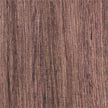 |
Palisander Rosewood (Dalbergia baroni):
The color varies from light violet to darker purples, sometimes with darker stripes. The best smelling wood around. Very hard with a somewhat open cell structure. As with most Rosewood, the tone is warm and the natural feel is fast.
Tone-O-Meter™
 |
|
YES |
NO |
|
| Used for neck backs |
X |
|
|
| Used for finger boards |
X |
|
|
| Finish required |
|
X |
|
| Used for bodies |
X |
|
|
|
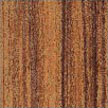 |
Pau Ferro (Machaerium villosum):
An excellent dense, hard wood with a very tight pore structure. This means it’s fast, smooth and extremely durable. An excellent choice for fretless fingerboards. Not only is it resistant to wear, but often the wood figuring is striking with variations in color from light tan to a dark coffee. The tone is brighter than Rosewood yet warmer than Ebony with plenty of articulation and attack. One of our favorite woods for fingerboards! No finish required
Tone-O-Meter™
 |
|
YES |
NO |
|
| Used for neck backs |
X |
|
|
| Used for finger boards |
X |
|
|
| Finish required |
|
X |
|
| Used for bodies |
|
X |
|
|
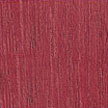 |
Purpleheart (Peltogyne pubesens):
The trademark purple-like color is striking and it is gaining in popularity. A very hard, dense wood for excellent sustain and similar to Bubinga in its thick well defined bottom. Looks great combined with bodies sporting purple finishes!
Tone-O-Meter™
 |
|
YES |
NO |
|
| Used for neck backs |
X |
|
|
| Used for finger boards |
X |
|
|
| Finish required |
|
X |
|
| Used for bodies |
X |
|
|
|
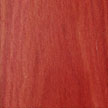 |
Satine (Brosimum paraense):
We also know this as Bloodwood because of its dark red color. A very dense, hard, tropical wood with a waxy smooth feel. Super tight grain pattern almost like Ebony, this wood is super fast to play on. Extended sustain and brilliant highs. Truly an incredible clean looking exotic.
Tone-O-Meter™
 |
|
YES |
NO |
|
| Used for neck backs |
X |
|
|
| Used for finger boards |
X |
|
|
| Finish required |
|
X |
|
| Used for bodies |
|
X |
|
|
 |
Walnut (Juglans nigra):
Walnut is the only North American dark wood. It is somewhat softer than maple though stiffer than mahogany. The sonic properties combine especially well with ebony fingerboards. Under a gloss, the grain is very deep, thick and rich looking.
Tone-O-Meter™
 |
|
YES |
NO |
|
| Used for neck backs |
X |
|
|
| Used for finger boards |
|
X |
|
| Finish required |
X |
|
|
| Used for bodies |
X |
|
|
|
 |
Wenge (Millettia laurentii):
A black hard wood with chocolate brown stripes. Very hard, coarser textured wood with open grain and very stiff. This wood makes awesome necks with strong midrange tones and warm lows. Combine it with an ebony fretboard for added highs or Brazilian Rosewood for a nice rounded upper tone. Bass players will be wowed by the punchy-ness, and guitar players will be awe struck at the howling mid-tones of their solos. Playing-wise, the coarse grain translates to less surface drag for your thumb while sliding. So though it’s coarse, it’s actually very fast while playing on it.
Tone-O-Meter™
 |
|
YES |
NO |
|
| Used for neck backs |
X |
|
|
| Used for finger boards |
X |
|
|
| Finish required |
|
X |
|
| Used for bodies |
X |
|
|
|




















